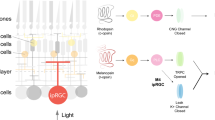Summary
The angular distribution of the optical axes of the ommatidia in the eyes of waterstriders (Gerris lacustris) has been investigated using antidromic illumination.
-
1.
Each eye contains about 920 ommatidia arranged in approximately 40 nearly horizontal rows (Figs. 5, 6).
-
2.
There is an acute zone (‘visual streak’) of ±5° around the eye equator with high vertical resolution (Fig. 9).
-
3.
The horizontal interommatidial angle ΔΦoh varies little with altitude and is in the frontal parts of the eye equal to the (horizontal) interrhabdomere angle ΔΦrh (Fig. 10).
-
4.
Above and below the ‘visual streak’ the eye is adapted to the perception of relative height or depth ‘constancy’ (Fig. 13).
-
5.
Reconstruction of the ‘viewing directions’ of the rhabdomeres in the ‘visual streak’ reveals that characteristic groups of rhabdomeres in different ommatidia coincide in their ‘receptive fields’. Optical prerequisites for two types of neural superposition can be found: one of medium neural summation but highest sampling frequency, the other of highest neural summation at the cost of resolution (Fig. 11).
-
6.
The correspondence of the limits of resolution due to diffraction and finite sampling frequency is discussed.
Similar content being viewed by others
References
Born M, Wolf E (1970) Principles of optics. Pergamon Press, Oxford
Dahmen HJ, Junger W (1988) Adaptation to the watersurface: structural and functional specialisation in the Gerrid eye. In: Elsner N, Barth FG (eds) Sense organs: interfaces between environment and behaviour. Thieme, Stuttgart, p 233
Franceschini N (1975) Sampling of the visual environment by the compound eye of the fly: fundamentals and applications. In: Snyder AW, Menzel R (eds) Photoreceptor optics. Springer, Heidelberg New York, pp 98–125
Horridge GA (1978) The separation of visual axes in apposition compound eyes. Phil Trans R Soc Lond B 285:1–59
Junger W, Dahmen HJ (1986) Visuell ausgelöstes Verhalten zur Kompensation von Verdriftung von Wasserläufern (Gerridae). Verb Dtsch Zool Ges 79:217
Junger W, Varjú D (1990) Drift compensation and its sensory basis in waterstriders (Gerris paludum F.). J Comp Physiol A167:441–446
Liche H (1936) Beobachtungen über das Verhalten der Wasserläufer (Gerridae, Hemiptera, Heteroptera). Bull Int Acad Polonaise Sci B II:525–546
Kirschfeld K (1976) The resolution of lens and compound eyes. In: Zettler F, Weiler R (eds) Neural principles in vision. Springer, Berlin Heidelberg New York, pp 354–370
Murphey RK (1971) Sensory aspects of the control of orientation to prey by the waterstrider, Gerris remigis. Z Vergl Physiol 72:168–185
Rensing L (1962) Beiträge zur vergleichenden Morphologic, Physiologie und Ethologie der Wasserlaufer (Gerroidae). Zool Beitr, NF 7:447–185
Schneider L, Langer H (1969) Die Struktur des Rhabdoms im “Doppelauge” des Wasserläufers Gerris lacustris. Z Zellforsch 99:538–559
Schwind R (1985) Sehen unter und über Wasser, Sehen von Wasser. Naturwissenschaften 72:343–352
Stavenga DG (1979) Pseudopupils of compound eyes. In: Autrum H (ed) Vision in invertebrates (Handb sens physiol, vol VII/6A). Springer, Berlin Heidelberg New York, pp 357–439
Wolburg-Buchholz K (1979) The organization of the lamina ganglionaris of the hemipteran insects, Notonecta glauca, Corixa punctata, Gerris lacustris. Cell Tissue Res 197:39–59
Zeil J, Nalbach HO, Nalbach G (1986) Eyes, eye stalks and the visual world of semi-terrestrial crabs. J Comp Physiol A 159:801–811
Author information
Authors and Affiliations
Rights and permissions
About this article
Cite this article
Dahmen, H. Eye specialisation in waterstriders: an adaptation to life in a flat world. J Comp Physiol A 169, 623–632 (1991). https://doi.org/10.1007/BF00193552
Accepted:
Issue Date:
DOI: https://doi.org/10.1007/BF00193552




